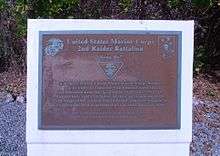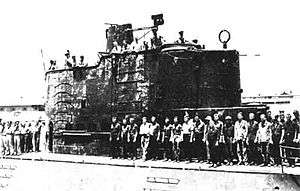Makin Island raid
Coordinates: 3°09′00″N 172°50′00″E / 3.15000°N 172.83333°E
| ||||||||||||||||||||||||||||||
The Makin Island Raid (occurred on 17–18 August 1942) was an attack by the United States Marine Corps Raiders on Japanese military forces on Makin Island (now known as Butaritari Island) in the Pacific Ocean. The aim was to destroy Japanese installations, take prisoners, gain intelligence on the Gilbert Islands area, and divert Japanese attention and reinforcements from the Allied landings on Guadalcanal and Tulagi.
Preparations and organization
The raid was among the first American offensive ground combat operations of World War II. The force was drawn from the 2nd Raider Battalion and comprised a small battalion command group and two of the Battalion's six rifle companies. Because of space limitations aboard ship, each company embarked without one of its rifle sections. Battalion headquarters, A Company and 18 men from B Company—totaling 121 troops—were embarked aboard the submarine Argonaut and the remainder of B Company—totaling 90 men—aboard Nautilus. The raiding force was designated Task Group 7.15 (TG 7.15).[2]
The Makin Atoll garrison was formed in 1942 as part of the Marshall Islands garrison and called the 62nd Garrison Force.[3] At the time of the Makin raid the total force opposing the American landings consisted of 71 armed personnel of the Japanese seaplane base led by Warrant Officer (Heisouchou) Kyuzaburo Kanemitsu of the Special Naval Landing Force equipped with light weapons. In addition there were also four members of the Seaplane Tender base and three members of a meteorological unit. Two civilian personnel were attached to the Japanese forces as interpreters and civilian administrators.
Execution of the raid

The Marine Raiders were launched in LCRL rubber boats powered by small, 6 hp (4.5 kW) outboard motors shortly after 00:00 (midnight) on 17 August. At 05:13, Companies A and B of the 2nd Raider Battalion—commanded by Lt. Col. Evans Carlson—successfully landed on Makin. The landing had been very difficult due to rough seas, high surf, and the failure of many of the outboard motors. Lt. Col. Carlson decided to land all his men on one beach, rather than two beaches as originally planned. At 05:15, Lt. Oscar Peatross and a 12-man squad landed on Makin. In the confusion of the landing, they did not get word of Carlson's decision to change plans and land all the Raiders on one beach. Thus, Peatross and his men landed where they originally planned. It turned out to be a fortunate error. Undaunted by the lack of support, Peatross led his men inland.
At 07:00, with Company A leading, the Raiders advanced from the beach across the island to its north shore before attacking southwestward. Strong resistance from Japanese snipers and machine guns stalled the advance and inflicted casualties. The Japanese then launched two banzai charges that were wiped out by the Raiders, thus killing most of the Japanese on the island. At 09:00, Lt. Peatross and his 12 men found themselves behind the Japanese who were fighting the rest of the Raiders to the east. Peatross's unit killed eight Japanese and the garrison commander Sgt. Major Kanemitsu, knocked out a machine gun and destroyed the enemy radios; but suffered three dead and two wounded. Failing to contact Carlson, they withdrew to the subs at dusk as planned.
At 13:30, 12 Japanese planes—including two flying boats—arrived over Makin. The flying boats—carrying reinforcements for the Japanese garrison—attempted to land in the lagoon, but were met with machine gun, rifle and Boys anti-tank rifle fire from the Raiders. One plane crashed; the other burst into flames. The remaining planes bombed and strafed but inflicted no U.S. casualties.
Evacuation of the Raiders
At 19:30, the Raiders began to withdraw from the island using 18 rubber boats, many of which no longer had working outboard motors. Despite heavy surf seven boats with 93 men made it to the subs. The next morning several boatloads of Raiders were able to fight the surf and reach the sub; but 72 men, along with just three rubber boats, were still on the island. At 23:30, the attempt by most of the Raiders to reach the submarines failed. Despite hours of heroic effort, 11 of 18 boats were unable to breach the unexpectedly strong surf. Having lost most of their weapons and equipment, the exhausted survivors struggled back to the beach to link up with 20 fully armed men who had been left on the island to cover their withdrawal. An exhausted and dispirited Carlson dispatched a note to the Japanese commander offering to surrender, but the Japanese messenger was killed by other Marines who were unaware of Carlson's plan.[4]
At 09:00 on 18 August, the subs sent a rescue boat to stretch rope from the ships to the shore that would allow the remaining Raiders' boats to be pulled out to sea. But just as the operation began, Japanese planes arrived and attacked, sinking the rescue boat and attacking the subs, which were forced to crash dive and wait on the bottom the rest of the day. The subs were undamaged. At 23:08, having managed to signal the subs to meet his Raiders at the entrance to Makin Lagoon, Carlson had a team, led by Lt. Charlie Lamb, build a raft made up of three rubber boats and two native canoes, powered by the two remaining outboard motors. Using this raft, 72 exhausted Raiders sailed 4 miles from Makin to the mouth of the lagoon, where the subs picked them up.
Casualties
USMC casualties were given as 18 killed in action and 12 missing in action. Of the 12 Marines missing in action, one was later identified among the 19 Marine Corps graves found on Makin Island.[5] Of the remaining eleven Marines missing in action, nine[6] were inadvertently left behind or returned to the island during the night withdrawal. They were subsequently captured, moved to Kwajalein Atoll, and executed by Japanese forces. Kōsō Abe was subsequently tried and executed by the Allies for the murder of the nine Marines.[7] The remaining two Marines missing in action have never been accounted for.[8]
Carlson reported that he had personally counted 83 Japanese bodies and estimated that 160 Japanese were killed based on reports from the Makin Island natives with whom he spoke. Additional Japanese personnel may have been killed in the destruction of two boats and two aircraft. Morison states that 60 Japanese were killed in the sinking of one of the boats. Japanese records are however more precise and the entire garrison casualties were 46 killed of all ranks (not including the purported large casualties Carlson reported for the boats he had sunk). This was confirmed when supporting Japanese forces returned to the island and found 27 Japanese survivors of the raid.[9]
Conclusions

Although the Marine Raiders succeeded in annihilating the Japanese garrison on the island, the raid failed to meet its other material objectives. No Japanese prisoners were taken, and no meaningful intelligence was collected. Also, no significant Japanese forces were diverted from the Solomon Islands area. In fact, because the vulnerabilities to their garrisons in the Gilbert Islands were highlighted by the raid, the Japanese strengthened their fortifications and defensive preparations on the islands in the central Pacific. As a result, the objective to dissipate Japanese forces may have had the unintended consequence of causing heavier losses for U.S. forces during the battles of the Gilbert and Marshall Islands campaigns. However, the raid did succeed in its objectives of boosting morale and testing Raider tactics.[10]
Bioarchaeological recovery
In 2000, 58 years after the raid, the remains of 19 Marines were found on Makin Island through bioarchaeological excavation and recovery, then sent to the Defense Department's Central Identification Laboratory in Hawaii, where they were identified. Six of these Marines were returned to their families for private burial ceremonies. The remaining 13 were buried with full honors at Arlington National Cemetery after a funeral service at Fort Myer Chapel at which the Marine Commandant General James L. Jones spoke. The remaining eleven Marines have not yet been located. [11]
See also
Notes
- ↑ (Morison, Coral Sea, Midway, and Submarine Actions, p. 235–241).
- ↑ Rottman (2005), pp.59–60.
- ↑ 第62警備隊
- ↑ p. 27 Wiles, Tripp Forgotten Raiders of '42: The fate of the Marines Left Behind on Makin Potomac Books, Inc., 31/03/2007
- ↑ Pacific Wrecks website
- ↑ Leatherneck forum
- ↑ Frank and Shaw, q. "Victory and Occupation". History of U.S. Marine Corps Operations in World War II. History Branch, U.S. Marine Corps. Retrieved 28 September 2012.
- ↑ Missing Marines Website
- ↑ Sato Kasumasa, "Gyokusai no Shima," Kojinsha Press, Tokyo,2004, pp.54-55,
- ↑ Pearl Harbor To Guadalcanal, History Of The Marine Corps Operations In World War II, Volume I, p. 284.
- ↑ http://www.arlingtoncemetery.net/raiders-1942.htm
References
- Hough, LtCol Frank O., USMCR; Maj Verle E. Ludwig, USMC, Henry I. Shaw, Jr., (1958). Pearl Harbor To Guadalcanal, History Of The Marine Corps Operations In World War II, Volume I. Washington, D.C.: United States Marine Corps. Cite uses deprecated parameter
|coauthors=(help) - Morison, Samuel Eliot (2001) [1949]. Coral Sea, Midway and Submarine Actions, May 1942 – August 1942, vol. 4 of History of United States Naval Operations in World War II. Champaign, Illinois, USA: University of Illinois Press. ISBN 978-0-252-06995-6.
- Morison, Samuel Eliot (1961). Aleutians, Gilberts and Marshalls, June 1942 – April 1944, vol. 7 of History of United States Naval Operations in World War II. Boston: Little, Brown and Company. ASIN B0007FBB8I.
- Rottman, Gordon; Duncan Anderson (consultant editor) (2005). US Special Warfare Units in the Pacific Theatre 1941–45. Oxford: Osprey. ISBN 1-84176-707-7. Cite uses deprecated parameter
|coauthors=(help) - Rottman, Gordon L. (2014). Carlson's Marine Raiders; Makin Island 1942. Oxford: Osprey Raid Series #44. ISBN 978-1-4728-0327-6.
- Peatross, Oscar F.; John P. McCarthy and John Clayborne (editors) (1995). Bless 'em All: The Raider Marines of World War II. Review. ISBN 0-9652325-0-6. Cite uses deprecated parameter
|coauthors=(help) - Smith, George W. (2003). Carlson's Raid: The Daring Marine Assault on Makin. Berkley Trade. ISBN 978-0-425-19019-7.- Neutral review of this book:
- Wiles, W. Emerson "Tripp" (2007). Forgotten Raiders of '42: The Fate of the Marines Left Behind on Makin. Potomac Books. ISBN 978-1-59797-055-6.
- Young, Howard. "Carlson's Raiders on Makin, 17–18 August 1942", Marine Corps Gazette 87(8): August 31, 2003.
External links
| Wikimedia Commons has media related to Makin Raid. |
- FROM MAKIN TO BOUGAINVILLE: Marine Raiders in the Pacific War by Major Jon T Hoffman, USMCR, official USMC historical account of raid
- World War II Submarines and Marines Unite, press release by Commander, Submarines Pacific, in 2000 summarizing the raid.
- Crowl, Philip A.; Edmund G. Love (1955). "Seizure of the Gilberts and Marshalls". United States Army in World War II — The War in the Pacific. Office of the Chief of Military History, Department of the Army. pp. 60–66. Retrieved January 23, 2007.- Briefly describes the Makin Raid and its impact on future U.S. operations in the Gilbert Islands.
- Hoffman, Jon T. (1995). "Makin" (brochure). FROM MAKIN TO BOUGAINVILLE: Marine Raiders in the Pacific War. Marine Corps Historical Center. Retrieved 2006-11-21.
- Whitman, Edward C. "SUBMARINE COMMANDOS: "Carlson's Raiders" at Makin Atoll". Undersea Warfare. United States Navy, Chief of Naval Operations, Submarine Warfare Division. Retrieved 2006-11-21.
- Enright, Ray (Director) (1943). 'Gung Ho!': The Story of Carlson's Makin Island Raiders (Feature-length film). Universal Pictures. — U.S. propaganda film that dramatizes the Makin Raid.
- CILHI Report of Makin USMC remains {Pdf download}
- list of 19 USMC KIA on Makin
- list of 9 USMC Killed on Kwajelein
- list of 2 USMC MIA

